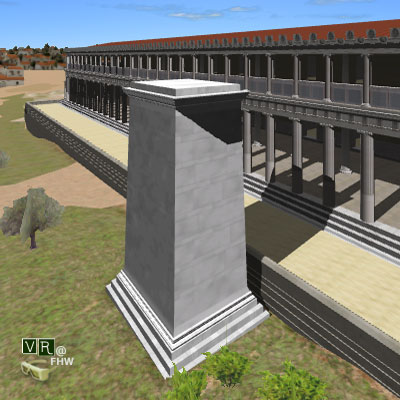Location: In front of the façade of the Stoa of Attalus (n. 22 in the Agora layout in the Guide: Mc CAMP II, J., The Athenian Agora: A Short Guide to the Excavations, Excavations of the Athenian Agora, Picture Book no 16, American School of Classical Studies, Princeton 2003, pp. 2 and 24-25), roughly in the middle of the eastern side
Date of Construction: (approx. 150 BC).
Periods of use: Hellenistic, Roman.
INTRODUCTION
The honorary pedestal and the four-in-hand chariot it supported, right in front of the Stoa of Attalus must have been constructed in parallel with the Stoa, around 150 BC and dedicated by the people of Athens to Attalus II, Athens’ patron. Shortly after 14 AD, the people of Athens re-dedicated this monument to Emperor Tiberius who had recently ascended to the throne and enjoined huge popularity at the time.
HELLENISTIC PERIOD
The foundations of the quadrilateral building excavated in front of the Stoa of Attalus, exactly in the centre of the East side and having the same orientation as its axis, were at first regarded by the excavators as a staircase which allowed access to the stoa from the east. Following the work carried out in 1949, it turn out that it was a much more solid structure, and was tentatively identified as a honorary pedestal. Further research led to the identification of a host of Hymettian marble fragments (over one hundred), most of them incorporated in the tower of the Late Roman wall (demolished in 1900 by the Archaeological Society) which today have been assembled in the original location of the monument. Some of these fragments originate from the upper part of the pedestal and bear openings for affixing the brass hooves of the horses, and this leads to the reconstruction of the structure as a pedestal supporting a brass four-in-hand chariot.
The quality of the building material, the pedestal’s dimensions and also the fact that it must have been constructed at the same time as the Stoa, lead to the conclusion that it is a monument dedicated to the founder of the Stoa, Attalus II, and must be dated to the middle of the 2nd cent. AD.
Although this structure has not been studied and no final reconstruction has been suggested, it is thought that it is very similar to the soaring monument ‘of Agrippa’ in front of the Propylaea of the Acropolis, which was erected in honour of Eumenes II after 178 BC, before its re-dedication to Augustus's close associate in the end of the 1st cent. BC, or in the beginning of the 1st cent. AD. This pedestal measured 8.91m in height, and the dimension of its upper part were 3.31 (E-W) Χ 3.80 (N-S).
ROMAN PERIOD
An inscription known since the 18th cent. already, initially incorporated into the tower of the Late Roman wall, rediscovered when the area surrounding the Stoa of Attalos was being cleared in 1949, mentions that the monument was dedicated by the people of Athens to Emperor Tiberius “the God”. From a methodical study of the inscription and of the circumstances surrounding we reach the conclusion that the monument was re-dedicated during the early days of Tiberius’ reign, shortly after 14 AD, when the Emperor was extremely popular in Greece. His worship as a god in Athens was prescribed by the Roman Senate, nor did the Emperor express such a wish; it was an initiative of the Athenians themselves.
The structure must have been destroyed in the 3rd cent. AD. As we have mentioned above, some of its structural material was incorporated in the wall of Valerian's time.
BIBLIOGRAPHY
Mc CAMP II, J.,
The Athenian Agora: A Guide to the Excavation and Museum, 4th ed., Athens 1990, pp.127-130.
Thompson, H.A., “Excavations in the Athenian Agora: 1949»,
Hesperia 19 (1950), pp. 317-318.
THOMPSON, H.A., WYCHERLEY, R.,
The Agora of Athens. The American Excavations in the Athenian Agora, vol. XIV, American School of Classical Studies at Athens, Princeton 1972, pp. 107.
Vanderpool, E., “Athens honors the Emperor Tiberius”,
Hesperia 28 (1959), pp. 86-90, tables 10-12 (the inscription of the monument’s re-dedication to Emperor Tiberius).

Honory pedestal, Representation in VR environment

